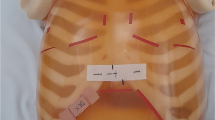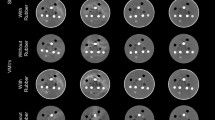Abstract
The most significant radiation field nonuniformity is the well-known Heel effect. This nonuniform beam effect has a negative influence on the results of computer-aided diagnosis of mammograms, which is frequently used for early cancer detection. This paper presents a method to correct all pixels in the mammography image according to the excess or lack on radiation to which these have been submitted as a result of the this effect. The current simulation method calculates the intensities at all points of the image plane. In the simulated image, the percentage of radiation received by all the points takes the center of the field as reference. In the digitized mammography, the percentages of the optical density of all the pixels of the analyzed image are also calculated. The Heel effect causes a Gaussian distribution around the anode–cathode axis and a logarithmic distribution parallel to this axis. Those characteristic distributions are used to determine the center of the radiation field as well as the cathode–anode axis, allowing for the automatic determination of the correlation between these two sets of data. The measurements obtained with our proposed method differs on average by 2.49 mm in the direction perpendicular to the anode–cathode axis and 2.02 mm parallel to the anode–cathode axis of commercial equipment. The method eliminates around 94% of the Heel effect in the radiological image and the objects will reflect their x-ray absorption. To evaluate this method, experimental data was taken from known objects, but could also be done with clinical and digital images.








Similar content being viewed by others
References
Rezentes PS, de Almeida A, Barnes GT: Mammography grid performance. Radiology 210:227–232, 1999
Kimme-Smith C, Sayre J, McCombs M, Gold RH, Basset LW: Mammography fixed grid versus reciprocating grid: evaluation using cadaveric breasts as test objects. Med Phys 23:141–147, 1996
Seibert JA, Boone JM: X-ray scatter removal by deconvolution. Med Phys 15:567–575, 1988
Highnam R, Brady M, English R: Detecting film-screen artifacts in mammography using a model-based approach. IEEE Trans Med Imag 18:1016–1024, 1999
Terry JA, Waggner RG, Blough MA: Half-value and intensity variations as a function of position in the radiation field for film-screen mammography. Med Phys 26:259–266, 1999
Behiels G, Maes F, Vandermeulen D, Suetens P: Retrospective correction of the heel effect in hand radiographs. Med Image Anal 6:183–190, 2002
Fung KKL, Gilboy WB: “Anode heel effect” on patient dose in lumbar spine radiography. Br J Radiol 73:531–536, 2000
Rangayyan RM, Ayres FJ, Desautels JEL: A review of computer-aided diagnosis of breast cancer: toward the detection of subtle signs. J Franklin Inst 344:312–348, 2007
Ferrari RJ, Rangayyan RM, Desautels JEL, Borges RA, Frere AF: Identification of the breast boundary in mammograms using active contour models. Med Biol Eng Comput 42:201–208, 2004
Nakayama R, Watanabe R, Namba K, Takeda K, Yamamoto K, Katsuragawa S, Doi K: Computer-aided diagnosis scheme for identifying histological classification of clustered microcalcifications by use of follow-up magnification mammograms. Acad Radiol 13:1219–1228, 2006
Cowen AR, Brettle DS, Workman A: Technical note: Compensation for field non-uniformity on a mammographic X-ray unit. Br J Radiol 66:150–154, 1993
Highnam R, Brady M, Shepstone B: A representation for mammographic image processing. Med Image Anal 1:1–18, 1996
Pawluczyk O, Yaffe MJ: Field nonuniformity correction for quantitative analysis of digitized mammograms. Med Phys 28:438–444, 2001
Meeson S, Young KC, Rust A, Wallis MG, Cooke J, Ramsdale ML: Implications of using high contrast mammography X-ray film-screen combinations. Br J Radiol 74:825–835, 2001
Marques MA, Frère AF, Oliveira HJQ, Azevedo-Marques PM, Schiabel H: Computerized method for radiologic systems parameters simulation intended to quality assurance programs. Med Biol Eng Comput 37:1244–1245, 1999
Fritz SL, Livingston WH: A comparison of computed and measured heel effect for various target angles. Med Phys 9:216–219, 1982
Brice DK: Stopping Powers for Electrons and Positrons, ICRU Report 37. Bethesda, MD: International Commission On Radiation Units And Measurements, 1984
Silva MA, Frère AF, Marques MA, Mattos LS: Heel effect’s influence on the performance of screen-film combinations. Med Biol Eng Comput 37:1258–1259, 1999
Boone JM, Chavez AE: Comparison of x-ray sections for diagnostic and therapeutic medical physics. Med Phys 23:1997–2005, 1996
Gonzalez RC, Woods RE: Digital Image Processing, 2nd edition. Englewood Cliffs, NJ: Prentice Hall, 2002
Press WH, Teukolsky SA, Vetterling WT, Flannery BP: Numerical Recipes in C. The Art of Scientific Computing, 2nd edition. Cambridge: Cambridge University Press, 1992
Lengyel E: Mathematics for 3D Games Programming and Computer Graphics, 2nd edition. Devon, UK: Charles River Media, 2003
Pratt WK: Correlation techniques of image registration. IEEE Trans Aerosp Electron Syst 10:353–358, 1974
Dekker N, Ploeger LS, Herk MV: Evaluation of cost functions for gray value matching of two-dimensional image in radiotherapy. Med Phys 30:778–784, 2003
Acknowledgments
The authors wish to express their appreciation for the financial support of FAPESP (Fundação de Amparo à Pesquisa do Estado de São Paulo).
Author information
Authors and Affiliations
Corresponding author
Rights and permissions
About this article
Cite this article
do Nascimento, M.Z., Frère, A.F. & Germano, F. An Automatic Correction Method for the Heel Effect in Digitized Mammography Images. J Digit Imaging 21, 177–187 (2008). https://doi.org/10.1007/s10278-007-9072-1
Received:
Revised:
Accepted:
Published:
Issue Date:
DOI: https://doi.org/10.1007/s10278-007-9072-1




